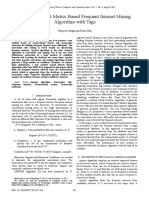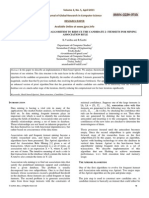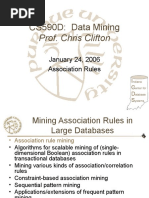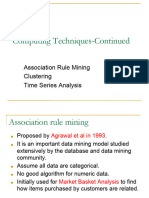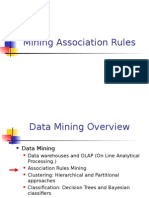Design and Implementation of Efficient APRIORI Algorithm
Uploaded by
sigma70egDesign and Implementation of Efficient APRIORI Algorithm
Uploaded by
sigma70egInternational Journal on Recent and Innovation Trends in Computing and Communication
Volume: 2 Issue: 5
ISSN: 2321-8169
1205 1208
_______________________________________________________________________________________________
Design and Implementation of Efficient APRIORI Algorithm
Rupinder Kaur, Rajeev Bedi, S. K. Gupta
Abstract: - Apriori algorithm is the classical algorithm used for association rule mining. This paper presents out the overview of basic
approaches used with the classical Apriori algorithm and formulates the problems associated with the classical approaches. This paper presents
out an enhanced Apriori algorithm that overcomes these limitations and is more efficient.
__________________________________________________*****_________________________________________________
I.
INTRODUCTION
Association rule mining is one of the data mining tasks that
are used for finding correlations between the transactions.
Association rules are if/then statements that are used for
finding relations between data in the database. An
association rule has two parts, an antecedent (if) and a
consequent (then). An antecedent is an item that is found in
the data. A consequent is an item that is found in
combination with the antecedent. Association rules are
created by analyzing data for frequent if/then patterns and
then support and confidence are the parameters that are used
to identify the most important relationships. Learning
association rules basically means finding the items that are
purchased together more frequently than others. Shopping
centers use association rules to place the items next to each
other so that users buy more items. Apriori is the classic and
probably the most basic algorithm to do association rule
mining.
II.
ASSOCIATION RULE MINING ALGORITHMS
Classical apriori algorithm
Apriori algorithmic rule is basic algorithmic rule for
association rule mining. It takings by distinctive the frequent
individual things within the data and lengthening them to
larger and bigger item sets as long as those item sets seem
sufficiently usually within the data. The frequent item sets
verified by Apriori are often used to determine association
rules that highlight general trends within the data.
Apriori uses a bottom-up approach, wherever frequent
subsets are extended one item at a time( a step called
candidate generation ), and tested against the data.
Algorithmic rule terminates once no winning extension units
are found. Apriori algorithmic rule generates frequent item
sets. If association item satisfies a definite minimum support
and minimum confidence then its thought about as a
frequent item. This whole algorithmic rule relies on plan of
looking out level by level.
Association rule mining is a 2 step process:i) Find all the frequent item sets from the data. If support of
associate item set A is larger than the minimum support i.e.,
support(A)>=minsup, them itemset a is thought as frequent
itemset otherwise not a frequent itemset.
ii) Generate association rules from the frequent itemsets.
Improved Apriori algorithm
Huiyang wang etc.al proposed two theorems to improve the
Aprirori algorithm to reduce the times of scanning
frequency itemsets.
Theorem1.:- suppose X and Y are two subsets of transaction
T and X is subset of Y. if Y is frequent itemset then X must
be frequent itemset.
Theorem 2:- suppose X and Y are two subsets of transaction
T and X is subset of Y. if Y is not frequent itemset then X
must not be frequent itemset.
Weighted apriori algorithm
Weighted approach with the basic APRIORI was introduced
to address the problem of using single minimum support for
selecting the frequent item sets. In the transactional
databases items are not uniformly distributed. Use of single
minimum support lead to either missing of rare association
rules if set too high or lead to combination explosion if set
too low. Weighted association rules deal with this issue. To
reflect different importance to different items, weights were
assigned to different items.
Consider D- transaction database
I= {i1, i2, i3} = set of items. Each transaction is
subset of I with transaction id-TID.
Then W= {w1,
corresponding to I.
w2,
w3.} is the
weight set
Classical algorithm was first used to obtain the frequent
item sets without weights. After weight assigning approach,
attributes with weighted support less than minimum
weighted support were removed.
PROBLEMS
ASSOCIATED
ALGORITHM
1.
2.
WITH
APRIORI
Candidate generation tries to load maximum no. of
subsets before each scan increasing execution time.
Bottom-up approach increases no. of scans required
for maximal subset.
III.
PROPOSED ALGOTIHM
CSk: Candidate item set of size k
LSk: Set of frequent items of size k
LS1= {frequent items};
Sort Item set LSk.
For (k= 1; Lk!=; k++) do begin
1205
IJRITCC | May 2014, Available @ http://www.ijritcc.org
_______________________________________________________________________________________
International Journal on Recent and Innovation Trends in Computing and Communication
Volume: 2 Issue: 5
ISSN: 2321-8169
1205 1208
_______________________________________________________________________________________________
CSk+1= candidates generated from LSk;
8. If No. Of Rules >= required No. Of rules Exit.
For each transaction t in database do
9. List Rules.
Increment count for items in CSk+1
LSk+1= candidates in Ck+1with min_support
Enhanced Apriori algorithm scans data base once. For each
row it builds list of possible pairs/permutations of elements.
On next row these build pairs are evaluated. After all
scanning rules are generated and disqualifying pair,
Elements are discarded from results.
End
HOW THE PROBLEM IS SOLVED
Return kLk;
1. Managing candidate items using sorted list reduces time
required to scans Items. Items are maintained in sorted form
so it requires lesser amount of time to insert new candidate
item.
That is contained in t
Sort candidate set CSk.
Steps:
1. Initialize variables
2. For each transaction in the DB T repeat 3-7:
3. Processor scans DB
identification set (TID).
and
creates
the
transaction
4. Apply Weights to Item sets.
2. Breadth first each: BFS helps in finding building rules as
we scan database instead of repeatedly scan database when
building rules. Because as we scan each transaction:
associations are generated.
5. For Each Row Repeat
IV.
a)
Prepare pairs common in rows.
b)
Eliminate pairs without common elements except
last element.
6. Calculate candidate k-item set counts, when the count is
greater than s, let freqk be frequent k-item sets.
EXPERIMENTAL RESULTS
Enhanced Apriori algorithm used the hybrid approach for
the association rule mining. Enhanced apriori algorithm
made use of concept of soting with the weighted approsch to
mine the association rules efficiently with the minimum
time possible.
7. Sort candidate Item sets.
Figure 1:- output screen
1206
IJRITCC | May 2014, Available @ http://www.ijritcc.org
_______________________________________________________________________________________
International Journal on Recent and Innovation Trends in Computing and Communication
Volume: 2 Issue: 5
ISSN: 2321-8169
1205 1208
_______________________________________________________________________________________________
Choose confidence 90% and 70% and analyze the curves of
time change with the change in support. As the support
increases runtime reduces gradually that shows the stability
of the proposed algorithm.
Figure 2:- Time change curve 1
Figure 3:-time change curve 2
Figure 4:- Reduced association rule records
1207
IJRITCC | May 2014, Available @ http://www.ijritcc.org
_______________________________________________________________________________________
International Journal on Recent and Innovation Trends in Computing and Communication
Volume: 2 Issue: 5
ISSN: 2321-8169
1205 1208
_______________________________________________________________________________________________
Figure 4 shows mining of database with association rule
with different minimum support degree. Horizontal axle
shows different support degrees in percentage and vertical
axle shows number of reducing records in the same
database.
REFERENCES
[1] Chun-Hao Chen, Guo-Cheng Lan, Tzung-Pei Hong, and YuiKai Lin, A High Coherent Association Rule Mining
Algorithm in the proceedings of IEEE international Conference
on Technologies and Applications of Artificial Intelligence,
Nov. 2012 , pp.1 4.
[2] Chun Zhang, Dezan Xie, Ning Zhang, HonghuiLi, The
Improvement of Apriori Algorithm and Its Application in
Fault Analysis of CRH EMU in the proceedings of IEEE
international conference on Service Operations, Logistics, and
Informatics (SOLI) , July 20l1, pp. 543 547.
[3] Hangbin LI, Shuhua CHEN, Jianchen LI, Shuo WANG,
Yihang FU An Improved Multi-Support Apriori Algorithm
Under the Fuzzy Item Association Condition in the
proceedings of IEEE international conference on Electronics,
Communications and Control (ICECC) Sept 2011, pp: 35393542.
[4] Huiying Wang, Xiangwei Liu, The Research of Improved
Association Rules Mining Apriori Algorithm in the
proceedings of IEEE Eighth International Conference on Fuzzy
Systems and Knowledge Discovery, July 2011, pp. 961-964.
[5] Idheba Mohamad Ali O. Swesi, Azuraliza Abu Bakar, Anis
Suhailis Abdul Kadir, Mining Positive and Negative
Association Rules from Interesting Frequent and Infrequent
Itemsets in the proceedings of IEEE 9th International Conference
on Fuzzy Systems and Knowledge Discovery (FSKD), May
2012, pp: 650-655.
[6] Jia Baohui,Wang Yuxin, Yang Zheng-qing, The Research of
Data Mining in AHM Technology based on Association Rule
in the proceedings of IEEE conference on Prognostics & System
Health Management May 2011, pp:1-8.
[7] Lei Chen, The Research of Data Mining Algorithm Based
on Association Rules in the proceedings of ICCASM 2nd
International Conference on Computer Application and System
modeling, 2012, pp: 0548-0551.
[8] Luo Fang, Qiu Qizhi, The Study on the Application of Data
Mining Based on Association Rules in the proceedings of IEEE
International Conference on Communication Systems and
Network Technologies May 2012, pp: 477-480.
Space Complexity in the proceedings of IEEE annual Indian
conference (INDICON) Dec 2012, pp: 1105-1110.
[10] Qiang Yang, Yanhong Hu, Application of Improved
Apriori Algorithm on Educational Information in the
proceedings of IEEE Fifth International Conference on Genetic
and Evolutionary Computing, Sept 2011, pp:330-332.
[11] Rina Raval, Prof. Indr Jeet Rajput , Prof. Vinitkumar Gupta,
Survey on several improved Apriori algorithm IOSR Journal
of Computer Engineering (IOSR-JCE) e-ISSN: 2278-0661, pISSN: 2278-8727 Volume 9, Issue 4 (Mar. - Apr. 2013), pp: 57-61.
[12] Rui Chang, Zhiyi Liu ,An Improved Apriori Algorithm in
the proceedings of IEEE International Conference on Electronics
and Optoelectronics (ICEOE), July 2011,pp: 476-478.
[13] Rupinder Kaur, Rajeev kumar Bedi, Sunil Kumar Gupta,
Review of association rule mining, International Journal of
Advanced Technology & Engineering Research (IJATER), ISSN
No: 2250-3536, Volume 4, Issue 2, March 2014,pp:14-17.
[14] Sandeep Singh Rawat, Lakshmi Rajamani, Probability
Apriori based Approach to Mine Rare Association Rules in
the proceedings of IEEE 3rd Conference on Data Mining and
Optimization (DMO) June 2011, pp: 253-258.
[15] S.Suriya , Dr.S.P.Shantharajah , R.Deepalakshmi , A
Complete Survey on Association Rule Mining with Relevance
to Different Domain International journal of advanced scientific
and technical research issue2, volume1 , Feb 2012, pp:163-168.
[16] Suraj P. Patil, A Novel Approach for Efficient Mining and
Hiding of Sensitive Association Rule in the proceedings of
Nirma university international conference on engineering,
December 2012, pp:1-6.
[17] Suraj P . Patil, U. M. Patil and Sonali Borse, The novel
approach for improving apriori algorithm for mining
association Rule World Journal of Science and Technology
2012, pp:75-78 .
[18] Xu Chil, ZHANG Wen Fang, Review of Association Rule
Mining Algorithm in Data Mining in the proceedings of IEEE
3rd International Conference on Communication Software and
Networks May 2011, pp. 512-516.
[19] Zhuang Chen, Shibang Cai, Qiulin Song and Chonglai Zhu
,An Improved Apriori Algorithm Based on Pruning
Optimization and Transaction Reduction in the proceedings of
IEEE 2nd international conference on Artificial Intelligence,
Management Science and Electronic Commerce (AIMSEC)
Aug 2011, pp: 1908-1911.
[9] Punit Mundra, Amit K Maurya, and Sanjay Singh, Enhanced
Mining Association Rule Algorithm with Reduced Time &
1208
IJRITCC | May 2014, Available @ http://www.ijritcc.org
_______________________________________________________________________________________
You might also like
- Strategic Occupational Health and Safety Plan100% (3)Strategic Occupational Health and Safety Plan23 pages
- Improved Apriori Algorithms - A Survey: Pranay Bhandari, K. Rajeswari, Swati Tonge, Mahadev ShindalkarNo ratings yetImproved Apriori Algorithms - A Survey: Pranay Bhandari, K. Rajeswari, Swati Tonge, Mahadev Shindalkar8 pages
- Mining of Frequent Item With BSW Chunking: Pratik S. Chopade Prof. Priyanka MoreNo ratings yetMining of Frequent Item With BSW Chunking: Pratik S. Chopade Prof. Priyanka More4 pages
- Comparative Study of Different Improvements of Apriori AlgorithmNo ratings yetComparative Study of Different Improvements of Apriori Algorithm4 pages
- Comparative Evaluation of Association Rule Mining Algorithms With Frequent Item SetsNo ratings yetComparative Evaluation of Association Rule Mining Algorithms With Frequent Item Sets7 pages
- "Fast Algorithms For Mining Association Rules" by Rakesh Agarwal Ramakrishnan SrikantNo ratings yet"Fast Algorithms For Mining Association Rules" by Rakesh Agarwal Ramakrishnan Srikant5 pages
- Study On Application of Apriori Algorithm in Data MiningNo ratings yetStudy On Application of Apriori Algorithm in Data Mining4 pages
- A New Efficient Matrix Based Frequent Itemset Mining Algorithm With TagsNo ratings yetA New Efficient Matrix Based Frequent Itemset Mining Algorithm With Tags4 pages
- An Approach of Improvisation in Efficiency of Apriori AlgorithmNo ratings yetAn Approach of Improvisation in Efficiency of Apriori Algorithm13 pages
- Volume 2, No. 5, April 2011 Journal of Global Research in Computer Science Research Paper Available Online at WWW - Jgrcs.infoNo ratings yetVolume 2, No. 5, April 2011 Journal of Global Research in Computer Science Research Paper Available Online at WWW - Jgrcs.info3 pages
- Frequent Patterns and Association Rule Mining: OutlineNo ratings yetFrequent Patterns and Association Rule Mining: Outline26 pages
- Online Message Categorization Using Apriori AlgorithmNo ratings yetOnline Message Categorization Using Apriori Algorithm7 pages
- Closet - An Efficient Algorithm For Mining FrequentNo ratings yetCloset - An Efficient Algorithm For Mining Frequent8 pages
- Apriori Based Novel Frequent Itemset Mining Mechanism: Issn NoNo ratings yetApriori Based Novel Frequent Itemset Mining Mechanism: Issn No8 pages
- Mining Association Rules in Large DatabasesNo ratings yetMining Association Rules in Large Databases77 pages
- Study of An Improved Apriori Algorithm For Data Mining of Association RulesNo ratings yetStudy of An Improved Apriori Algorithm For Data Mining of Association Rules8 pages
- Feature Extraction and Reduction by using ModifiedApriori algorithm (1)No ratings yetFeature Extraction and Reduction by using ModifiedApriori algorithm (1)9 pages
- Mining Association Rules in Large DatabasesNo ratings yetMining Association Rules in Large Databases40 pages
- Literature Survey On Various Frequent Pattern Mining AlgorithmNo ratings yetLiterature Survey On Various Frequent Pattern Mining Algorithm7 pages
- APznzaYKXa5YwGceeu2-5Hb2cWsN90NIV1g8I9DxBLLoKwuE7P4qjOfEGWd6pCzfmwSqKnWNBm5euXlo07JZKRKi-UcpBSTEjg7UTMzxCaVnPn0Jb2VsTE_sqVGq7R0pvAGyLrtvL4jK7B1dY1fgM9rEecJTtpRn5WSkJB__vFz_Re2xK6z3uN9DfvIaFgXRVYH8z-mJcY-z6Q8hhRFSOdNo ratings yetAPznzaYKXa5YwGceeu2-5Hb2cWsN90NIV1g8I9DxBLLoKwuE7P4qjOfEGWd6pCzfmwSqKnWNBm5euXlo07JZKRKi-UcpBSTEjg7UTMzxCaVnPn0Jb2VsTE_sqVGq7R0pvAGyLrtvL4jK7B1dY1fgM9rEecJTtpRn5WSkJB__vFz_Re2xK6z3uN9DfvIaFgXRVYH8z-mJcY-z6Q8hhRFSOd174 pages
- FALLSEM2022-23 SWE2009 ETH VL2022230101117 Reference Material I 25-08-2022 Frequent Pattern MiningNo ratings yetFALLSEM2022-23 SWE2009 ETH VL2022230101117 Reference Material I 25-08-2022 Frequent Pattern Mining42 pages
- Usage of Apriori Algorithm of Data Mining As An Application To Grievous Crimes Against WomenNo ratings yetUsage of Apriori Algorithm of Data Mining As An Application To Grievous Crimes Against Women6 pages
- CSE 634 Data Mining Techniques: Mining Association Rules in Large DatabasesNo ratings yetCSE 634 Data Mining Techniques: Mining Association Rules in Large Databases41 pages
- Performance Analysis of Distributed Association Rule Mining With Apriori AlgorithmNo ratings yetPerformance Analysis of Distributed Association Rule Mining With Apriori Algorithm5 pages
- Improving Efficiency of Apriori Algorithm Using Transaction ReductionNo ratings yetImproving Efficiency of Apriori Algorithm Using Transaction Reduction4 pages
- Module 5.1 - Association Rule Mining, Apriori Algorithm, Data Mining, Support, Confidence, Examples100% (1)Module 5.1 - Association Rule Mining, Apriori Algorithm, Data Mining, Support, Confidence, Examples108 pages
- Predicting Missing Items in A Shopping Cart Using Apriori AlgorithmNo ratings yetPredicting Missing Items in A Shopping Cart Using Apriori Algorithm3 pages
- Fast Algorithms For Mining Association RulesNo ratings yetFast Algorithms For Mining Association Rules13 pages
- CIS664-Knowledge Discovery and Data MiningNo ratings yetCIS664-Knowledge Discovery and Data Mining74 pages
- Optimization Algorithms For Association Rule Mining (ARM) : K.IndiraNo ratings yetOptimization Algorithms For Association Rule Mining (ARM) : K.Indira118 pages
- Convicted of Fatigue Driving - Artikel - 2No ratings yetConvicted of Fatigue Driving - Artikel - 27 pages
- Barrier Analysis: Technical Research and Analysis CenterNo ratings yetBarrier Analysis: Technical Research and Analysis Center29 pages
- The Statistical Analysis of Crash-Frequency DataNo ratings yetThe Statistical Analysis of Crash-Frequency Data49 pages
- Intro To Polar Coordinates: Lesson 6.5ANo ratings yetIntro To Polar Coordinates: Lesson 6.5A17 pages
- Safety Performance Functions - Tools For Improved Use of Safety and Exposure DataNo ratings yetSafety Performance Functions - Tools For Improved Use of Safety and Exposure Data4 pages
- AR20001119 Astellia Preliminary Voice Auditreport RANo ratings yetAR20001119 Astellia Preliminary Voice Auditreport RA33 pages
- VESTEL Installationsguide EVC04-AC11SW-T2P ENNo ratings yetVESTEL Installationsguide EVC04-AC11SW-T2P EN47 pages
- 10 USB Projects With The Leonardo - 30 Arduino Projects For The Evil Genius - Second EditionNo ratings yet10 USB Projects With The Leonardo - 30 Arduino Projects For The Evil Genius - Second Edition8 pages
- Specifications For On Grid Solar Panel SystemNo ratings yetSpecifications For On Grid Solar Panel System9 pages
- Lm3241 6-Mhz, 750-Ma Miniature, Adjustable, Step-Down DC-DC Converter For RF Power AmplifiersNo ratings yetLm3241 6-Mhz, 750-Ma Miniature, Adjustable, Step-Down DC-DC Converter For RF Power Amplifiers28 pages
- Eilbeck Cranes Manual 41526 M 5440 MN G 0001No ratings yetEilbeck Cranes Manual 41526 M 5440 MN G 0001123 pages
- Aurii Secret 4G - Custom Recovery and RootNo ratings yetAurii Secret 4G - Custom Recovery and Root9 pages
- Selection Standards Implemented in QM-SOFTNo ratings yetSelection Standards Implemented in QM-SOFT1 page
- Improved Apriori Algorithms - A Survey: Pranay Bhandari, K. Rajeswari, Swati Tonge, Mahadev ShindalkarImproved Apriori Algorithms - A Survey: Pranay Bhandari, K. Rajeswari, Swati Tonge, Mahadev Shindalkar
- Mining of Frequent Item With BSW Chunking: Pratik S. Chopade Prof. Priyanka MoreMining of Frequent Item With BSW Chunking: Pratik S. Chopade Prof. Priyanka More
- Comparative Study of Different Improvements of Apriori AlgorithmComparative Study of Different Improvements of Apriori Algorithm
- Comparative Evaluation of Association Rule Mining Algorithms With Frequent Item SetsComparative Evaluation of Association Rule Mining Algorithms With Frequent Item Sets
- "Fast Algorithms For Mining Association Rules" by Rakesh Agarwal Ramakrishnan Srikant"Fast Algorithms For Mining Association Rules" by Rakesh Agarwal Ramakrishnan Srikant
- Study On Application of Apriori Algorithm in Data MiningStudy On Application of Apriori Algorithm in Data Mining
- A New Efficient Matrix Based Frequent Itemset Mining Algorithm With TagsA New Efficient Matrix Based Frequent Itemset Mining Algorithm With Tags
- An Approach of Improvisation in Efficiency of Apriori AlgorithmAn Approach of Improvisation in Efficiency of Apriori Algorithm
- Volume 2, No. 5, April 2011 Journal of Global Research in Computer Science Research Paper Available Online at WWW - Jgrcs.infoVolume 2, No. 5, April 2011 Journal of Global Research in Computer Science Research Paper Available Online at WWW - Jgrcs.info
- Frequent Patterns and Association Rule Mining: OutlineFrequent Patterns and Association Rule Mining: Outline
- Online Message Categorization Using Apriori AlgorithmOnline Message Categorization Using Apriori Algorithm
- Closet - An Efficient Algorithm For Mining FrequentCloset - An Efficient Algorithm For Mining Frequent
- Apriori Based Novel Frequent Itemset Mining Mechanism: Issn NoApriori Based Novel Frequent Itemset Mining Mechanism: Issn No
- Study of An Improved Apriori Algorithm For Data Mining of Association RulesStudy of An Improved Apriori Algorithm For Data Mining of Association Rules
- Feature Extraction and Reduction by using ModifiedApriori algorithm (1)Feature Extraction and Reduction by using ModifiedApriori algorithm (1)
- Literature Survey On Various Frequent Pattern Mining AlgorithmLiterature Survey On Various Frequent Pattern Mining Algorithm
- APznzaYKXa5YwGceeu2-5Hb2cWsN90NIV1g8I9DxBLLoKwuE7P4qjOfEGWd6pCzfmwSqKnWNBm5euXlo07JZKRKi-UcpBSTEjg7UTMzxCaVnPn0Jb2VsTE_sqVGq7R0pvAGyLrtvL4jK7B1dY1fgM9rEecJTtpRn5WSkJB__vFz_Re2xK6z3uN9DfvIaFgXRVYH8z-mJcY-z6Q8hhRFSOdAPznzaYKXa5YwGceeu2-5Hb2cWsN90NIV1g8I9DxBLLoKwuE7P4qjOfEGWd6pCzfmwSqKnWNBm5euXlo07JZKRKi-UcpBSTEjg7UTMzxCaVnPn0Jb2VsTE_sqVGq7R0pvAGyLrtvL4jK7B1dY1fgM9rEecJTtpRn5WSkJB__vFz_Re2xK6z3uN9DfvIaFgXRVYH8z-mJcY-z6Q8hhRFSOd
- FALLSEM2022-23 SWE2009 ETH VL2022230101117 Reference Material I 25-08-2022 Frequent Pattern MiningFALLSEM2022-23 SWE2009 ETH VL2022230101117 Reference Material I 25-08-2022 Frequent Pattern Mining
- Usage of Apriori Algorithm of Data Mining As An Application To Grievous Crimes Against WomenUsage of Apriori Algorithm of Data Mining As An Application To Grievous Crimes Against Women
- CSE 634 Data Mining Techniques: Mining Association Rules in Large DatabasesCSE 634 Data Mining Techniques: Mining Association Rules in Large Databases
- Performance Analysis of Distributed Association Rule Mining With Apriori AlgorithmPerformance Analysis of Distributed Association Rule Mining With Apriori Algorithm
- Improving Efficiency of Apriori Algorithm Using Transaction ReductionImproving Efficiency of Apriori Algorithm Using Transaction Reduction
- Module 5.1 - Association Rule Mining, Apriori Algorithm, Data Mining, Support, Confidence, ExamplesModule 5.1 - Association Rule Mining, Apriori Algorithm, Data Mining, Support, Confidence, Examples
- Predicting Missing Items in A Shopping Cart Using Apriori AlgorithmPredicting Missing Items in A Shopping Cart Using Apriori Algorithm
- Optimization Algorithms For Association Rule Mining (ARM) : K.IndiraOptimization Algorithms For Association Rule Mining (ARM) : K.Indira
- Learn Design and Analysis of Algorithms in 24 HoursFrom EverandLearn Design and Analysis of Algorithms in 24 Hours
- Barrier Analysis: Technical Research and Analysis CenterBarrier Analysis: Technical Research and Analysis Center
- Safety Performance Functions - Tools For Improved Use of Safety and Exposure DataSafety Performance Functions - Tools For Improved Use of Safety and Exposure Data
- AR20001119 Astellia Preliminary Voice Auditreport RAAR20001119 Astellia Preliminary Voice Auditreport RA
- 10 USB Projects With The Leonardo - 30 Arduino Projects For The Evil Genius - Second Edition10 USB Projects With The Leonardo - 30 Arduino Projects For The Evil Genius - Second Edition
- Lm3241 6-Mhz, 750-Ma Miniature, Adjustable, Step-Down DC-DC Converter For RF Power AmplifiersLm3241 6-Mhz, 750-Ma Miniature, Adjustable, Step-Down DC-DC Converter For RF Power Amplifiers















